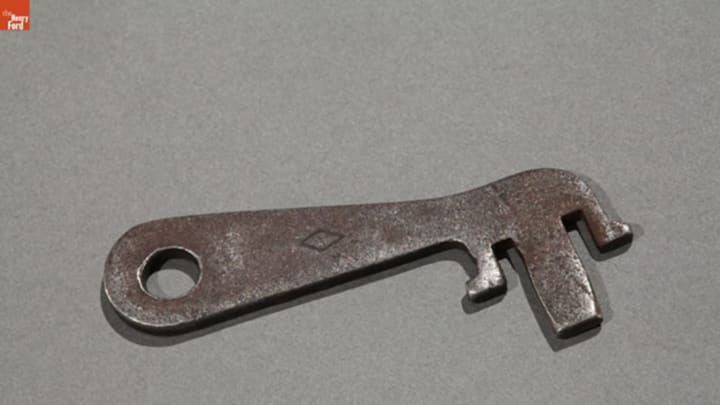Show & Tell: Ford Model T Ignition Key

This ignition key, produced for the Ford Model T between 1914 and 1919, is a relic of a time when the operation of an automobile required much more from the driver than it does today. The metal key, slightly rusted, is now preserved in the collections of The Henry Ford in Dearborn, Michigan.
The pre-1919 Model T, Car and Driver advises, is especially difficult to get going because it doesn’t have a manual starter. Here is the procedure, as described by Car & Driver for those interested in driving a restored specimen: The driver starts at the front of the car, by the right fender, and pulls the choke, while cranking a lever under the radiator to prime the carburetor. Then, she climbs into the car. This is where the ignition key comes into play: she inserts it, then adjusts the timing stalk, the throttle stalk, and the hand brake. Then, she hops back out of the car to crank the lever, using (Car and Driver advises) the left arm: “If the engine backfires and the lever swings counterclockwise, the left arm is less likely to be broken.” At that point, the engine should start.
A group of friends in their Model T Ford car circa 1915. Getty Images.
The elaborate nature of this procedure meant that the driver had to be ready to remember a lot of technical details, and to have a modicum of physical strength. While some contemporary critics argued that women couldn’t handle a Model T, drivers like Britain’s Dorothy Levitt, who wrote a 1909 handbook for women interested in buying and operating an automobile, insisted that the level of technical expertise necessary was easy to acquire: “An engine is easily mastered. A few hours of proper diligence, provided you are determined to learn, and you know all that you have to know.”
Dorothy Levitt in The Woman and the Car: A Chatty Little Handbook For All Women Who Motor Or Who Want to Motor // Public Domain
Ford’s Model T was unusual in sticking to the crank starter method throughout the 1910s. The electric starter motor, patented in 1903, could be found in most non-Ford cars as the second decade of the 20th century progressed, and their manufacturers boasted of the relative ease of their cars’ starting procedures (the tagline of a Cadillac ad: “The Car That Has No Crank”). While the whole procedure was rendered somewhat simpler with the advent of Ford’s Model A—the driver no longer had to get out of the car and crank—it still wasn’t easy, when compared with our super-quick present-day process.